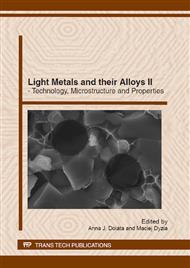[1]
Requena G., Degischer H.P., Creep behaviour of unreinforced and short fibre reinforced AlSi12CuMgNi piston alloy, Materials Science and Engineering A 420 (2006), 265–275
DOI: 10.1016/j.msea.2006.01.024
Google Scholar
[2]
Jun D., Yaohui L., Sirong Y., Wenfang L., Effect of heat-treatment on friction and wear properties of Al2O3 and carbon short fibres reinforced AlSi12CuMgNi hybrid composites, Wear 262 (2007), 1289–1295
DOI: 10.1016/j.wear.2006.11.020
Google Scholar
[3]
Kaczmar J.W., Pietrzak K., Włosiński W.: The production and application of metal matrix composite materials, Journal of Material Processing Technology, 106 (2000), 58-67
DOI: 10.1016/s0924-0136(00)00639-7
Google Scholar
[4]
W. Hufenbach, M. Gude, A. Czulak, J. Śleziona, A. Dolata-Grosz, M. Dyzia "Development of textile-reinforced carbon fibre aluminium composites manufactured with gas pressure infiltration methods" Journal of Achievements in Materials and Manufacturing Engineering, Vol. 35, Issues 2, pp.177-183, (2009)
DOI: 10.4028/www.scientific.net/msf.690.116
Google Scholar
[5]
Śleziona J., Bases of the technology of composites, Publishing company of the Silesian University of Technology, Gliwice 1998, 28.
Google Scholar
[6]
Sobczak J., Wojciechowski S., Contemporary tendencies of the practical application of metal composites, Composites, 2(2002)3.
Google Scholar
[7]
Rosso M., Ceramic and metal matrix composites: Routes and properties, Journal of Materials Processing Technology 175 (2006) 364–375
DOI: 10.1016/j.jmatprotec.2005.04.038
Google Scholar
[8]
Scherm F., Völkl R., Neubrand A., Bosbach F., Glatzel U., Mechanical characterization of interpenetrating network metal–ceramic composites, Materials Science and Engineering, A 527 (2010), 1260-1265.
DOI: 10.1016/j.msea.2009.09.063
Google Scholar
[9]
Aldrich D.E., Fan Z., Microstructural characterisation of interpenetrating nickel/alumina composites, Materials Characterization 47 (2001), 167– 173
DOI: 10.1016/s1044-5803(01)00183-8
Google Scholar
[10]
Konopka K., Olszówka–Myalska A., Szafran M., Ceramic–metal composites with an interpenetrating network, Materials Chemistry and Physics, 81 (2003) 329–332.
DOI: 10.1016/s0254-0584(02)00595-3
Google Scholar
[11]
Poniznik Z., Salit V., Basista M., Gross D., Effective elastic properties of interpenetrating phase composites, Computational Materials Science 44 (2008) 813–820
DOI: 10.1016/j.commatsci.2008.06.010
Google Scholar
[12]
Chabera P., Boczkowska A., Zych J., Oziębło A., Kurzydłowski K.J., Effect of specific surface fraction of interphase boundaries on mechanical properties of ceramic-metal composites, obtained by pressure infiltration, Kompozyty 11: 3 (2011) 202-207
Google Scholar
[13]
Pagounis E., Talvitie M., Lindroos V.K., Influence of the metal/ceramic interface on the microstructure and mechanical properties of hiped iron-based composites, Composites Science and Technology, 56 (1996).
DOI: 10.1016/s0266-3538(96)00101-7
Google Scholar
[14]
Potoczek M., Śliwa R.E., Myalski J., Śleziona J., Metal-ceramic composites obtained by the pressure infiltration of metal into the ceramic preform about the structure of foam, Ores and non-ferrous metals, R54 2009 nr 11.
Google Scholar
[15]
Szafran M., Konopka K, Rokicki G, Lipiec W., Kurzydłowski K. J., Porous ceramics infiltrated of metals and polymers, Composites 2002, 2, 5, 313.
Google Scholar
[16]
Binner J., Chang H., Higginson R., Processing of ceramic-metal interpenetrating composites, Journal of the European Ceramic Society, 29 (2009), 837–842.
DOI: 10.1016/j.jeurceramsoc.2008.07.034
Google Scholar
[17]
Chang H., Higginson R., Binner J., Microstructure and property characterisation of 3-3 Al(Mg)/Al2O3 interpenetrating composites produced by a pressureless infiltration technique, J Mater Sci (2010), 45:662–668
DOI: 10.1007/s10853-009-3983-9
Google Scholar
[18]
Oziębło A., Jaegerman Z., Traczyk S., Dziubak C., Porowata ceramika do wytwarzania kompozytowych materiałów metalowo-ceramicznych metodą infiltracji ciśnieniowej ciekłymi stopami aluminium, Szkło i Ceramika, Rocznik 57 (2006).
Google Scholar
[19]
A. Dolata-Grosz, M. Dyzia, J. Śleziona: "Manufacture and structure of infiltrated of Al-carbon fibres composites" Archives of Mechanical Technology and Automation Vol. 30, no 3, pp.11-18, 2010.
Google Scholar
[20]
A. Dolata-Grosz, M. Dyzia, J. Śleziona: Structure of Al-CF composites obtained by infiltration methods, Archives of Foundry Engineering, Vol. 11, Special Issue 2, pp.23-28, 2011.
Google Scholar
[21]
A. Dolata-Grosz, M. Dyzia, J. Śleziona: Al/CF composites obtained by infiltration method, Kompozyty (Composites), vol. 4, 2011.
Google Scholar


